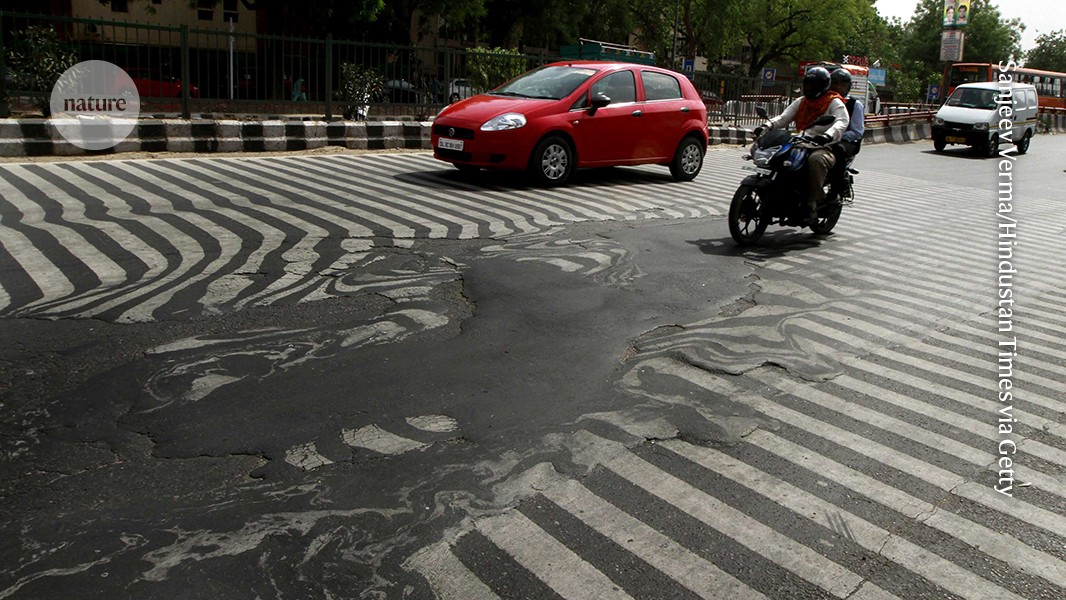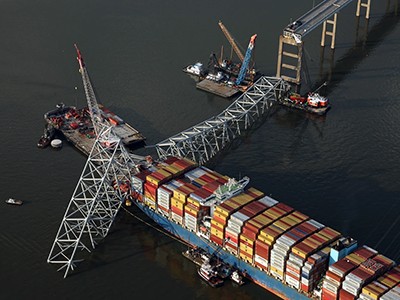Climate change is making heatwaves more frequent and severe. In June, at least 1,300 people died because of heat during the annual Hajj pilgrimage in Saudi Arabia, marking a higher toll than in previous years. People living in the tropics experience the worst effects of heat. But by 2100, three-quarters of the world’s population could be exposed to climatic conditions that exceed a lethal threshold of temperature and humidity, compared with just under one-third in 20001.
Transport systems, too, are adversely affected. Extreme heat buckles rails, melts wires and road surfaces and bursts tyres. This year, traffic in India has been disrupted by melting road surfaces. And last summer, bus passengers in Houston, Texas, had to wait in bus shelters hot enough to make people ill. During the 2022 heatwave in the United Kingdom, scores of flights were disrupted by melting runways and trains were delayed by warped rails.
Such problems will grow as the world warms. For example, by 2050, Spain could face up to 500 cases of rail buckling each year, compared with 20 expected in 20252. By 2100, pavements in New Hampshire might need to be replaced every 4 years, compared with every 16 years today3. Also by the end of the century, annual costs of road and rail operation and maintenance in the European Union and United Kingdom are projected to increase by €0.9 billion (US$1 billion) compared with 2016 if there is 1.5 °C of global warming above pre-industrial levels, and by €4.8 billion for 4 °C of warming4.
Risks of bridge collapses are real and set to rise — here’s why
The effects will be felt unevenly, with disadvantaged communities hit the hardest. For example, in Oregon, between 2012 and 2017, the number of people taking the bus on very hot days (30 °C or more) dropped by 1.6% in lower-income neighbourhoods, by 1% in middle-income ones, and hardly at all in high-income areas5. Governments, bus and rail operators and cities should urgently prepare transport systems for a warmer future. But efforts so far have been inadequate. Just over 160 countries mention ‘transport’ in their policies for adapting to extreme heat. Yet, few have progressed from planning to implementation, owing to lack of funding, prioritization, coordination, technical expertise and capacity, as well as uncertainty over what the future holds.
A comprehensive, strategic approach is needed. Existing frameworks for coping with extreme heat either focus only on disaster response or single out physical transport infrastructure without considering the people who use it. A wider range of climate-change hazards, vulnerabilities, risks and infrastructure conditions needs to be factored in.
Here we propose a road map to strengthen transport systems’ heat resilience. In the short and medium term, transport operators should assess climate risks and the feasibility of various solutions and implement some ‘low regret’ options to improve resilience to extreme weather. In the longer term, strategies need to be designed to improve the resilience of transport steadily as conditions change. This road map reflects deliberations of an expert panel on transport infrastructure and extreme heat, convened with funding from the Global Facility for Disaster Reduction and Recovery.
Set up a governance framework
The first step is to establish what immediate risks extreme heat poses to local, regional and national transport networks and users. Municipalities and other areas should set up a transport task force of researchers, agencies, citizens, policymakers and governments. The task force should consider climate projections and impact assessments from the Intergovernmental Panel on Climate Change and the annual United Nations Framework Convention on Climate Change Conference of the Parties. Mitigation or adaptation strategies already in place for heatwaves should be identified. All modes of transport need to be represented, including by air, water, rail and roads.
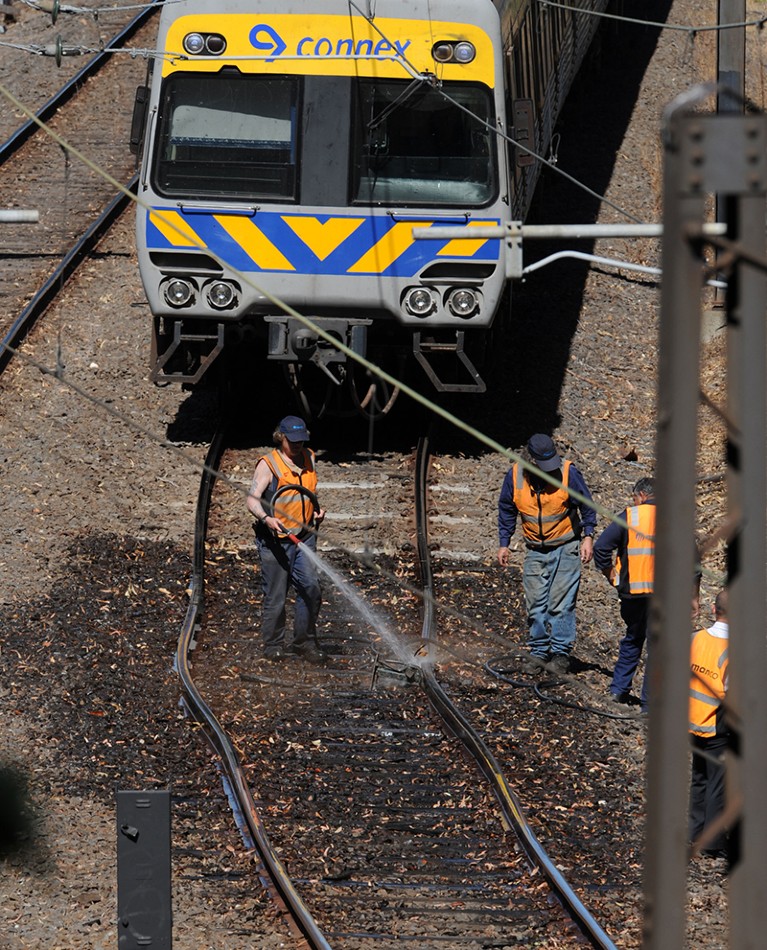
Cooling railway tracks with water or by using white paint can reduce rail buckling.
Governance should be put in place — heat policies remain scarce worldwide. Ideally, a regional chief heat officer would coordinate efforts across sectors. As well as protecting human health, policies should consider the resilience of transport infrastructure to heat, how best to guide investments and how to avoid failures of crucial systems. First responders, utility companies and transport-concession firms should be involved in shaping policies.
Transport should be embedded in all heatwave-related efforts. Impacts on movement of people and goods should be included, as is the case in the US National Integrated Heat Health Information System (NIHHIS), created by the National Oceanic and Atmospheric Administration and Centers for Disease Control and Prevention. The NIHHIS compiles and shares information about extreme heat with the public and with decision makers.
International collaboration is crucial. This includes in capacity building, finance to support adaptation to heat and sharing tools and data for assessing risks. The Global Heat Health Information Network, run by the World Health Organization and the World Meteorological Organization, is one such forum.
Best practices can be borrowed from other sectors. For example, flood risk governance has specific objectives, such as preventing a once-every-100-years flood. Heat governance needs equivalent targets for planning.
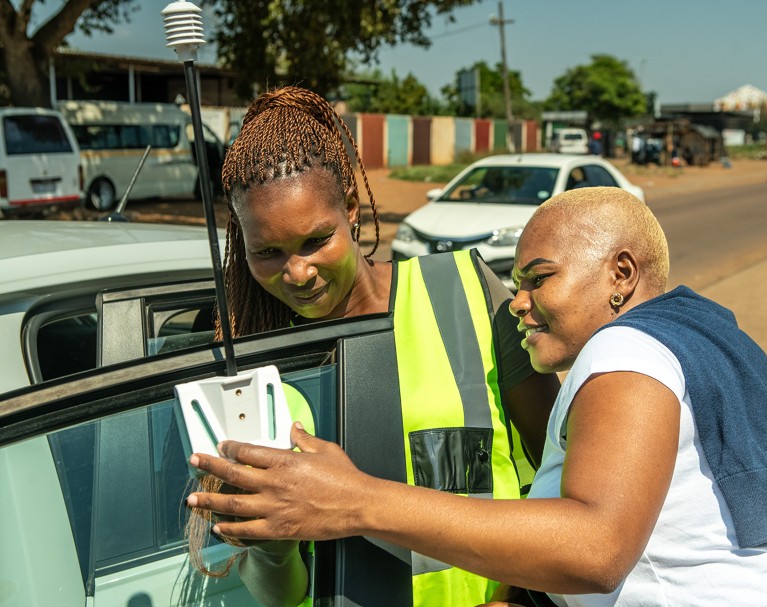
Volunteers in Cape Town, South Africa, are attaching sensors to their cars to map heat across the city.Credit: Chris Morgan/World Bank
Deploy sensors and monitoring
Temperature sensors and monitoring systems should be installed along transport networks, especially around the most vulnerable parts, such as exposed sections of railway track and underground infrastructure with poor ventilation6. Combining temperature sensors with Internet of Things technologies can enable real-time monitoring of conditions. This would allow improved planning for maintenance as well as better-informed, local, dynamic responses to changing weather conditions — for instance, imposing speed restrictions to improve safety.
Start feasibility studies
Practical assessments should start as soon as possible to test existing heat-adaptation strategies in various geographical contexts. Tempe in Arizona, Abu Dhabi and Singapore are increasing the amount of shade provided for pedestrians, cyclists, passengers and transport workers, such as bus drivers and maintenance staff7. Phoenix, Arizona, has installed ‘cool pavements’, by applying coatings that reflect solar radiation. Spain is using heat sensors on rail tracks to provide early warnings, as well as heat-reflective coatings and paints to limit rail temperature increases. The United Kingdom sets speed limits during heatwaves to prevent rail buckling and reduce the risk of accidents.
Cost–benefit analyses are needed to prioritize strategies, resources and investments. In Seoul, for example, transforming roads into green corridors has been a cost-effective way to reduce heatwave impacts for pedestrians, cyclists and public-transport users.
Develop tools for adaptation
Given uncertainty about the extent and impacts of climate change, governments and cities need to develop ‘resilience toolkits’ for keeping the transport sector running in extreme conditions. Such tools range from simple rules of thumb for local practitioners to ‘digital twins’ of transport systems for monitoring and planning. Current toolkits tend to focus only on local climate risks (see go.nature.com/3sazyuk) or on public health (the NIHHIS, for example).
To inform these toolkits, transport managers need to gather meteorological data, predict future climate patterns, assess the heat resilience of infrastructure components and monitor user exposure to heat.
Transport toolkits should be aligned with wider climate adaptation strategies or pathways. They should support an iterative process for continual improvement: both the infrastructure and toolkit should evolve as the climate changes8. Policymakers should identify pathways that optimize resilience with minimal financial outlay, unless investment permits pricier alternatives that will result in longer-term resilience. They can and should make decisions and adjustments as conditions evolve. Standards and design guidelines for heat-resilient systems will also need to be updated regularly as harsh conditions become more frequent6.
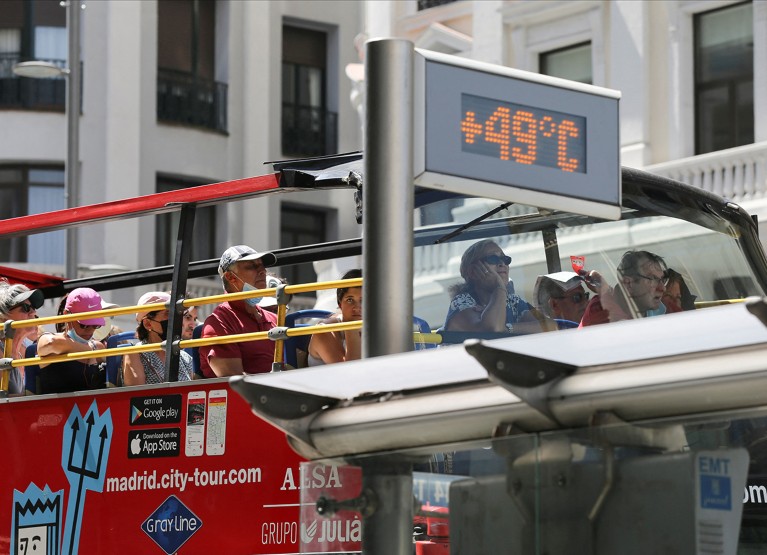
Countries should put guidelines for public transport in place to account for increasingly hot conditions.Credit: Isabel Infantes/Reuters
Invest in technological innovations
Governments must invest in research and development to foster technological innovations that address the challenges posed by extreme heat. For example, thermochromic materials, which change colour with temperature, can be used for regulating temperature in both hot and cold conditions. However, current versions are expensive and degrade when exposed to ultraviolet radiation. Techniques for storing heat, such as graphite-powder-filled pavements, can help to regulate pavement temperatures. Renewable-energy technologies can also be installed in pavements to harvest heat from them and turn it into electricity. Bus stops are being upgraded with cooling panels and industrial fans.
Consider heat equity
Low-income households, people of colour, women, older people and those with disabilities are affected disproportionately by heatwaves. In 2018, for example, 20% of women cancelled metro trips in Delhi because of extreme heat, compared with around 10% of men9. Women might be more vulnerable to extreme heat than men, because of physiological differences, cultural norms or responsibilities, for instance. More research is necessary to better understand such disparities.
To address heat inequity, planners and decision makers must engage with marginalized communities to understand their specific challenges and concerns and incorporate the input into heat strategies. Widespread tree-planting campaigns and financial incentives for green roofs, for example, can improve living conditions in cities for everyone. For example, in Los Angeles, California, the Cool LA programme was launched in 2019 to lay 400 kilometres of cool pavements and plant about 2,000 trees in low-income areas. Other interventions include establishing cooling centres and improving public-transport infrastructure and services. For instance, Kelowna in Canada offers free public transport for people travelling to and from cooling centres and sprays water vapour on some pedestrian areas when heat warnings are issued.
Education and awareness campaigns are essential to ensure all community members can access information about heat risks and protective measures. More actions must be taken to integrate heat equity into the transport-planning process to avoid climate gentrification and favouring of the wealthiest.
Resilient and inclusive systems can better serve the needs of all residents, irrespective of their socio-economic status or background. The time to act is now — the costs of inaction will only grow as our world continues to warm.


